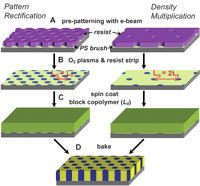| The ability to create features using directed self-assembly from pre-patterned templates, as reported in two recent Science papers, may further address the needs of the integrated circuit industry for specific design approaches. |
A review by Jeff Morse , PhD. National Nanomanufacturing Network
- Ruiz, R., et al., Density Multiplication and Improved Lithography by Directed Block Copolymer Assembly, Science, 321 (2008) 936-939. DOI: 10.1126/science.1157626
- Bita, I., et al., Graphoepitaxy of Self-Assembled Block Copolymers on Two-Dimensional Periodic Patterned Templates, Science, 321 (2008) 939-943. DOI: 10.1126/science.1159352
As present approaches to reduce the length scales associated with electronic and memory devices encounter intrinsic economical and technological limits via optical lithography, the so-called “engine of the semiconductor industry,” new approaches to forming nanoscale patterns exhibiting long-range order are receiving significant attention. While self-assembly techniques exploiting the properties of block copolymers result in pattern formations on the order of the length scale of the constituent blocks (˜3-50 nm), achieving long-range nanoscopic order over macroscopic dimensions has been elusive, along with high defect densities present in the patterns that further limit the applications for which these approaches are useful. In the case of magnetic storage devices, the demands by the industry on feature size and reproducibility outpace those of the integrated circuit industry in their goal to achieve >1Tbit/in2 by 2010. This translates to bit patterns of roughly 27 nm with similar spacing, which must be produced over a 95-mm diameter master template from which the storage media discs will be produced.
Adobe Fireworks CS6 - https://abcoemstore.com/product/adobe-fireworks-cs6/ is the version of Fireworks that was included with Adobe Creative Suite 6 Design & Web Premium and Master Collection.

These methods, which impart improved ordering in block copolymer films, are referred to as chemical pre-patterning, or graphoepitaxy in the case of physical pre-patterning of the substrate surface. In both examples, a top-down lithographic process is combined with a bottom-up self-assembly process to achieve the desired result. The significant result is that critical nanomanufacturing issues are addressed in terms of defects, process scaleup, and process design. Future research directions will likely explore means for extending the pattern multiplication factors, as well as possibly forming the pre-pattern template through more conventional optical lithography capabilities. Ultimately, the ability to create features using directed self-assembly from pre-patterned templates may further address the needs of the integrated circuit industry for specific design approaches.
Image from Ruiz , R., et al., Density Multiplication and Improved Lithography by Directed Block Copolymer Assembly, Science, 321 (2008) 936-939. Reprinted with permission of the AAAS.
This work is licensed under a Creative Commons Attribution-NonCommercial-NoDerivs 3.0 Unported.
